Papers by Michael Ciccotti

Orthopaedic Journal of Sports Medicine
Objectives: In cases of patellar dislocation, surgical intervention is typically reserved for pat... more Objectives: In cases of patellar dislocation, surgical intervention is typically reserved for patients with recurrent instability, unless a chondral or osteochondral fragment is identified following the initial dislocation. There is concern that multiple dislocation events may result in a higher incidence of articular cartilage injury. The purpose of this study is to compare the incidence of articular cartilage damage in patients with a single patellar dislocation to those with multiple patellar dislocations, and secondarily to compare the location and severity of chondral injury between the groups. Methods: Patients diagnosed with patellar dislocation were retrospectively identified by ICD-9 & ICD-10 codes from 2017-2021. Inclusion criteria were patients with a documented history of patellar dislocation with an MRI of the affected knee available for review. Patients with articular cartilage injury prior to dislocation event were excluded. Medical records were reviewed to determine ...

Orthopaedic Journal of Sports Medicine
Objectives: Despite successful return to sport (RTS) outcomes after posteromedial osteophyte rese... more Objectives: Despite successful return to sport (RTS) outcomes after posteromedial osteophyte resection, one possible consequence of removing this osteophyte is increased stress on the ulnar collateral ligament (UCL), leading to a UCL injury. It is currently unknown how often overhead athletes who have an isolated posteromedial osteophyte resection progress to require UCL reconstruction (UCLR). Therefore, the purpose of this study was to report outcomes following arthroscopic resection of posteromedial osteophyte in overhead athletes and determine if baseball pitchers who underwent arthroscopic posteromedial osteophyte resection for posteromedial impingement went on to require UCL surgery. Methods: All patients who underwent elbow arthroscopy from 2010-2020 were reviewed. Patients were included if they underwent isolated arthroscopic posteromedial osteophyte resection without concomitant UCL surgery, were overhead athletes at the onset of posteromedial impingement symptoms and had no...

Orthopaedic Journal of Sports Medicine
Objectives: The purpose of this study was to determine the return to sport (RTS) rate and perform... more Objectives: The purpose of this study was to determine the return to sport (RTS) rate and performance upon RTS in professional baseball players who underwent biceps tenodesis. A secondary purpose was to compare the postoperative performance of the group of players who underwent biceps tenodesis to a group of matched controls. Methods: All professional baseball pitchers who underwent biceps tenodesis between 2014 and 2017 were included. Players with concomitant rotator cuff repair were excluded. Demographic and performance data (preoperative and postoperative) were recorded for each player. Performance metrics were then compared between the biceps tenodesis and matched control (no history of biceps tenodesis) groups. Results: 14 players (average age 27±4 years; 12 pitchers, 2 position outfielders) were included. Most (79%) were open subpectoral tenodeses while two were arthroscopic biceps transfers, and one was an arthroscopic suprapectoral tenodesis. Fixation methods included cortic...

Orthopaedic Journal of Sports Medicine
Objectives: Though contralateral trunk tilt has been frequently studied in baseball pitchers, the... more Objectives: Though contralateral trunk tilt has been frequently studied in baseball pitchers, the phenomena of excessive ipsilateral trunk tilt has not been explored as a potential correlate with throwing arm kinetics. Excessive ipsilateral trunk tilt is often observed during earlier portions of the pitch cycle. High school pitchers with excessive contralateral trunk tilt during the late cocking phase of pitching have been noted to have significantly faster ball velocity, as well as increased elbow distraction force, shoulder distraction force, elbow varus torque, and shoulder internal rotation torque. Collegiate pitchers with excessive contralateral trunk tilt at maximum shoulder external rotation and at ball release have significantly faster ball velocity and higher elbow varus torque. The purpose of this study was to evaluate the effect of ipsilateral and contralateral trunk tilt on kinetic and kinematic parameters among high school and professional baseball pitchers. Methods: Pr...

Orthopaedic Journal of Sports Medicine
Objectives: Injury of the ulnar collateral ligament (UCL) has become increasingly common, particu... more Objectives: Injury of the ulnar collateral ligament (UCL) has become increasingly common, particularly in overhead athletes. There is no consensus on management of the ulnar nerve in UCL reconstruction (UCLR) in patients with pre-operative ulnar nerve symptoms, as literature supports both not decompressing the nerve as well as ulnar nerve transposition (UNT). The purpose of this study is to compare subjective clinical outcomes and return to play metrics between patients who received UNT during UCLR and a matched cohort who underwent UCLR alone. We hypothesized that there would be no significant difference in patient outcomes or return to sport (RTS) metrics between the cohorts. Methods: Using an institutional database, patients who underwent UCLR with UNT between 2007 and 2017 were retrospectively identified. These patients were matched based on sex, age at surgery (± 3 years), and BMI (± 2) to a comparison group that underwent UCLR alone. Patients completed the Kerlan Jobe Orthopae...

Orthopaedic Journal of Sports Medicine
Objectives: Tranexamic acid (TXA) is widely used in arthroplasty procedures and has recently gain... more Objectives: Tranexamic acid (TXA) is widely used in arthroplasty procedures and has recently gained popularity as an adjunct for improving perioperative outcomes after arthroscopic procedures. However, the safety, side-effect profile, and efficacy of various routes of administration (intravenous and intraarticular) of tranexamic acid in arthroscopic surgery have not been clearly delineated. The objectives of this study are to analyze the available literature on overall safety, efficacy, and complications such as deep vein thrombosis, pulmonary embolus, and infection following administration of intravenous (IV) or intraarticular (IA) tranexamic acid in arthroscopic procedures. Methods: A literature search in agreement with the Preferred Reporting Items from Systematic Reviews and Meta-Analyses (PRISMA) protocol was performed to retrieve randomized controlled trials examining the use of tranexamic acid at the time of arthroscopic procedures. Inclusion criteria included randomized cont...

Orthopaedic Journal of Sports Medicine
Objectives: Outcomes following anterior cruciate ligament reconstruction (ACLR) are generally goo... more Objectives: Outcomes following anterior cruciate ligament reconstruction (ACLR) are generally good/excellent. While some risk factors for poor outcomes following ACLR have been determined, there are many that remain unknown. It is unclear if an elevated tibial tubercle trochlear groove (TT-TG) distance is a risk factor for poor outcomes following ACLR. Therefore, the purpose of this study was to determine if an elevated TT-TG increases risk of failure following ACLR. The authors hypothesized that patients with an elevated TT-TG will have an increased risk of failure following ACLR. Methods: All patients who underwent primary ACLR at a single institution between July 2018-June 2019 with a minimum of 2-year follow-up were eligible for inclusion. TT-TG distance was measured on preoperative magnetic resonance imaging (MRI) scans by 2 independent investigators. Clinical outcomes, complication rates, ability to RTS, and Lysholm scores were compared between patients with a TT-TG < 12.5m...
Arthroscopy: The Journal of Arthroscopic & Related Surgery, 2022
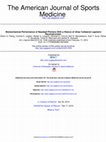
The American journal of sports medicine, Jan 17, 2015
A relatively high number of active professional baseball pitchers have a history of ulnar collate... more A relatively high number of active professional baseball pitchers have a history of ulnar collateral ligament reconstruction (UCLr) on their throwing elbow. Controversy exists in the literature about whether professional baseball pitchers regain optimal performance after return from UCLr. It has been suggested that pitchers may have different biomechanics after UCLr, but this has not been previously tested. It was hypothesized that, compared with a control group without a history of UCLr, professional pitchers with a history of UCLr would have (1) significantly different throwing elbow and shoulder biomechanics; (2) a shortened stride, insufficient trunk forward tilt, and excessive shoulder horizontal adduction, characteristics associated with "holding back" or being tentative; (3) late shoulder rotation; and (4) improper shoulder abduction and trunk lateral tilt. Controlled laboratory study. A total of 80 active minor league baseball pitchers (and their 8 Major League Bas...

Arthroscopy: The Journal of Arthroscopic & Related Surgery, 2022
The purpose of this paper is to provide updated information for sports healthcare specialists reg... more The purpose of this paper is to provide updated information for sports healthcare specialists regarding the disabled throwing shoulder (DTS). A panel of experts, recognized for their experience and expertise in this field, was assembled to address and provide updated information on several topics that have been identified as key areas in creating the DTS spectrum. Each panel member submitted a concise presentation on one of the topics within these areas, each of which were then edited and sent back to the group for their comments and consensus agreement in each area. Part two presents the following consensus conclusions and summary findings regarding pathomechanics and treatment, including (1) internal impingement results from a combination of scapular protraction and humeral head translation; (2) the clinically significant labral injury that represents pathoanatomy can occur at any position around the glenoid, with posterior injuries most common; (3) meticulous history and physical examination, with a thorough kinetic chain assessment, is necessary to comprehensively identify all the factors in the DTS and clinically significant labral injury; (4) surgical treatment should be carefully performed, with specific indications and techniques incorporating low profile implants posterior to the biceps that avoid capsular constraint; (5) rehabilitation should correct all kinetic chain deficits while also developing high-functioning, throwing-specific motor patterns and proper distribution of loads and forces across all joints during throwing; and (6) injury risk modification must focus on individualized athlete workload to avoid overuse. LEVEL OF EVIDENCE: V, expert opinion.
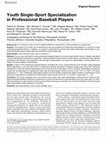
Orthopaedic Journal of Sports Medicine
Background: An increasing number of youth baseball athletes are specializing in playing baseball ... more Background: An increasing number of youth baseball athletes are specializing in playing baseball at younger ages. Purpose: The purpose of our study was to describe the age and prevalence of single-sport specialization in a cohort of current professional baseball athletes. In addition, we sought to understand the trends surrounding single-sport specialization in professional baseball players raised within and outside the United States (US). Study Design: Cross-sectional study; Level of evidence, 3. Methods: A survey was distributed to male professional baseball athletes via individual team athletic trainers. Athletes were asked if and at what age they had chosen to specialize in playing baseball at the exclusion of other sports, and data were then collected pertaining to this decision. We analyzed the rate and age of specialization, the reasons for specialization, and the athlete’s perception of injuries related to specialization. Results: A total of 1673 professional baseball athlet...
Arthroscopy: The Journal of Arthroscopic & Related Surgery, 2004

The American Journal of Sports Medicine, 1992
The purpose of this study was to assess the effect of synthetic augmentation of a bone-patellar t... more The purpose of this study was to assess the effect of synthetic augmentation of a bone-patellar tendon-bone allograft on the basis of biomechanical, morphologic, and histologic evaluation. The anterior cruciate ligament was reconstructed in the left knee of 66 adult sheep. Half the knees received bone-patellar tendon-bone grafts alone, while the other half were augmented. All of the knees, including the contralateral controls, had gross and histologic examination, hydroxyproline assay for collagen content, and biomechanical testing in groups at 0, 4, 16, and 52 weeks postoperatively. Biomechanical testing included anteroposterior trans lation, ultimate tensile strength, energy to failure, stiff ness, and mode of failure. Eight fresh bone-patellar tendon-bone allografts were compared to eight cryo preserved bone-patellar tendon-bone allografts for baseline data on the effects of the cryopreservation. Cryopreservation did not have any effect on graft characteristics. Gross and histolo...
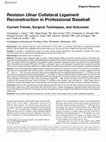
The American Journal of Sports Medicine, 2010
BackgroundRevision ulnar collateral ligament reconstruction remains a challenging problem. The ob... more BackgroundRevision ulnar collateral ligament reconstruction remains a challenging problem. The objective of this study was to biomechanically evaluate an ulnar collateral ligament reconstruction technique using a suspension button fixation technique that can be used even in the case of ulnar cortical bone loss.HypothesisAn ulnar suspension fixation technique for ulnar collateral ligament reconstruction can restore elbow kinematics and demonstrate failure strength comparable to that of currently available techniques.Study DesignControlled laboratory study.MethodsNine pairs of cadaveric elbows were dissected free of soft tissue and potted. After simulating ulnar cortical bone loss, ulnar collateral ligament reconstruction was performed in 1 elbow of each pair using palmaris longus autograft and a 30-mm RetroButton suspended from the far (lateralmost) ulnar cortex. A docking technique was used for humeral fixation of the graft. Elbow valgus angle was quantified using a Microscribe 3DLX...
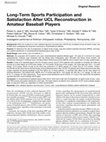
Orthopaedic Journal of Sports Medicine
Background: While the incidence of ulnar collateral ligament reconstruction (UCLR) has increased ... more Background: While the incidence of ulnar collateral ligament reconstruction (UCLR) has increased across all levels of play, few studies have investigated the long-term outcomes in nonprofessional athletes. Purpose: To determine the rate of progression to higher levels of play, long-term patient-reported outcomes (PROs), and long-term patient satisfaction in nonprofessional baseball players after UCLR. Study Design: Case series; Level of evidence, 4. Methods: We evaluated UCLR patients who were nonprofessional baseball athletes aged <25 years at a minimum of 5 years postoperatively. Patients were assessed with the Kerlan-Jobe Orthopaedic Clinic Shoulder and Elbow Score (KJOC), the Timmerman-Andrews (T-A) Elbow score, the Mayo Elbow Performance Score (MEPS), and a custom return-to-play questionnaire. Results: A total of 91 baseball players met the inclusion criteria, and 67 (74%) patients were available to complete the follow-up surveys at a mean follow-up of 8.9 years (range, 5.5-...
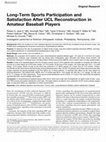
Background: While the incidence of ulnar collateral ligament reconstruction (UCLR) has increased ... more Background: While the incidence of ulnar collateral ligament reconstruction (UCLR) has increased across all levels of play, few studies have investigated the long-term outcomes in nonprofessional athletes. Purpose: To determine the rate of progression to higher levels of play, long-term patient-reported outcomes (PROs), and long-term patient satisfaction in nonprofessional baseball players after UCLR. Study Design: Case series; Level of evidence, 4. Methods: We evaluated UCLR patients who were nonprofessional baseball athletes aged <25 years at a minimum of 5 years postoperatively. Patients were assessed with the Kerlan-Jobe Orthopaedic Clinic Shoulder and Elbow Score (KJOC), the Timmerman-Andrews (T-A) Elbow score, the Mayo Elbow Performance Score (MEPS), and a custom return-to-play questionnaire. Results: A total of 91 baseball players met the inclusion criteria, and 67 (74%) patients were available to complete the follow-up surveys at a mean follow-up of 8.9 years (range, 5.5-...

Orthopaedic Journal of Sports Medicine
Objectives: While results following ulnar collateral ligament (UCL) injury in baseball players ha... more Objectives: While results following ulnar collateral ligament (UCL) injury in baseball players has been well documented, results following UCL injury in gymnasts are not well documented. As such, the purpose of this study was to report the operative and non-operative outcomes of UCL injury in gymnasts. Methods: Gymnasts who underwent UCL injury treatment whether non-operative or operative at a single institution were evaluated at a minimum of 2 years post-operatively. Patients were assessed with Kerlan-Jobe Orthopaedic Clinic Shoulder and Elbow Score (KJOC), Mayo Elbow Performance Score (MEPS), Andrews-Timmerman (A-T) Elbow score, Quick Disabilities of the Arm, Shoulder and Hand (qDASH) score and a custom return to play survey. Results: There were 11 patients who met inclusion criteria and complete follow-up was available in 9 patients. Overall, 6 patients were treated operatively (4 UCL reconstructions (UCLR) and 2 UCL repairs) and 3 patients were treated non-operatively. One UCLR ...

Orthopaedic Journal of Sports Medicine
Objectives: Osteochondritis dissecans (OCD) of the humeral capitellum is a common elbow injury in... more Objectives: Osteochondritis dissecans (OCD) of the humeral capitellum is a common elbow injury in adolescent overhead throwing athletes likely secondary to the excessive valgus stress placed on the joint during the throwing motion. The purpose of this study is to retrospectively investigate the clinical findings and outcomes, including return to play rates, of overhead throwing athletes who underwent elbow arthroscopy for the treatment of osteochondral lesions of elbow. Methods: Throwing athletes who underwent elbow arthroscopy over an eight-year period, 2010 to 2018, were identified and included in our analysis. From this cohort of patients, those who were treated for OCD of the elbow joint and were baseball players were selected for analysis. Non-baseball athletes and those who underwent a concurrent procedure that required an open approach were excluded. Patients were contacted via phone to complete the Kerlan-Jobe Orthopaedic Clinic Shoulder and Elbow Score (KJOC), the Mayo Elbo...










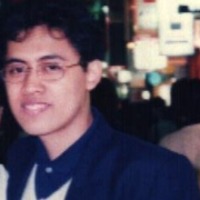
Uploads
Papers by Michael Ciccotti